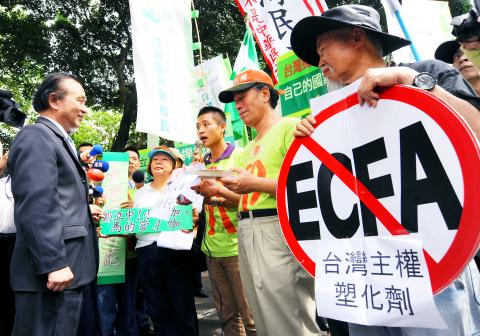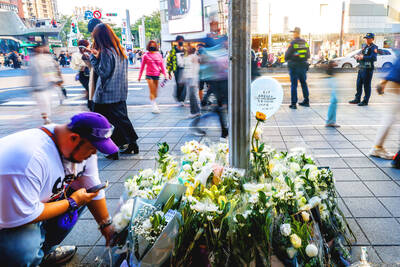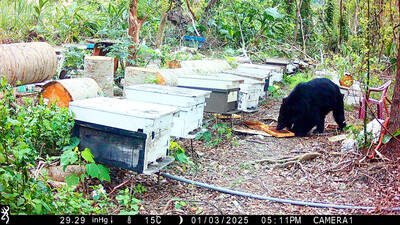About 30 protesters armed with signs and slogans were cordoned off by plainclothes police outside the Grand Hotel in Taipei yesterday where a meeting between cross-strait negotiators was being held.
The gathering, led by the Alliance of Referendum for Taiwan, was part of ongoing protests the group has planned against all types of cross-strait meetings, with the protest’s leaders saying interactions have eroded Taiwanese sovereignty.
“Taiwan and China, each side is a different country,” chanted members of the group, most of whom were middle-aged or elderly, before several of them ripped up paper emblems of the Republic of China and People’s Republic of China combined on one flag.

Photo: Lo Pei-der, Taipei Times
The protesters were held back by a dozen plainclothes officers who cordoned the group into a small area outside the main gate of the hotel.
Prevented from entering the hotel, the protest’s leaders decided to hand a Straits Exchange Foundation official on the scene a pot filled with dried jasmine flowers and a bottle containing di(2-ethylhexyl) phthalate, or DEHP, the chemical at the center of the recent food scare in Taiwan.
The two items were chosen because they were representative of cross-strait relations, said Chang Ming-yu (張銘祐), an executive director of the alliance.
“The flowers represent Taiwan’s democracy and freedoms that are being taken away by closer interactions between Taiwan and China,” Chang said. “Meanwhile, DEHP products have been found only in Taiwan and not China — despite being made by the same company in one instance.”
It shows the cross-strait inequality and how in some cases inferior products are left in Taiwan while better products are exported across the Taiwan Strait, he said.
“We will continue to monitor and protest cross-strait discussions,” he said, echoing promises by other pro-independence group leaders to rally against cross-strait meetings, regardless of whether they are of business nature or other.
Earlier the alliance, the Northern Taiwan Society and other groups gathered at the legislature where, supported by a Democratic Progressive Party lawmaker, said cross-strait pacts have failed to make life better for most Taiwanese.

SHIPS, TRAINS AND AUTOMOBILES: The ministry has announced changes to varied transportation industries taking effect soon, with a number of effects for passengers Beginning next month, the post office is canceling signature upon delivery and written inquiry services for international registered small packets in accordance with the new policy of the Universal Postal Union, the Ministry of Transportation and Communications said yesterday. The new policy does not apply to packets that are to be delivered to China, the ministry said. Senders of international registered small packets would receive a NT$10 rebate on postage if the packets are sent from Jan. 1 to March 31, it added. The ministry said that three other policies are also scheduled to take effect next month. International cruise ship operators

HORROR STORIES: One victim recounted not realizing they had been stabbed and seeing people bleeding, while another recalled breaking down in tears after fleeing A man on Friday died after he tried to fight the knife-wielding suspect who went on a stabbing spree near two of Taipei’s busiest metro stations, Taipei Mayor Chiang Wan-an (蔣萬安) said. The 57-year-old man, identified by his family name, Yu (余), encountered the suspect at Exit M7 of Taipei Main Station and immediately tried to stop him, but was fatally wounded and later died, Chiang said, calling the incident “heartbreaking.” Yu’s family would receive at least NT$5 million (US$158,584) in compensation through the Taipei Rapid Transit Corp’s (TRTC) insurance coverage, he said after convening an emergency security response meeting yesterday morning. National

PLANNED: The suspect visited the crime scene before the killings, seeking information on how to access the roof, and had extensively researched a 2014 stabbing incident The suspect in a stabbing attack that killed three people and injured 11 in Taipei on Friday had planned the assault and set fires at other locations earlier in the day, law enforcement officials said yesterday. National Police Agency (NPA) Director-General Chang Jung-hsin (張榮興) said the suspect, a 27-year-old man named Chang Wen (張文), began the attacks at 3:40pm, first setting off smoke bombs on a road, damaging cars and motorbikes. Earlier, Chang Wen set fire to a rental room where he was staying on Gongyuan Road in Zhongzheng District (中正), Chang Jung-hsin said. The suspect later threw smoke grenades near two exits

The Forestry and Nature Conservation Agency yesterday launched a gift box to market honey “certified by a Formosan black bear” in appreciation of a beekeeper’s amicable interaction with a honey-thieving bear. Beekeeper Chih Ming-chen (池明鎮) in January inspected his bee farm in Hualien County’s Jhuosi Township (卓溪) and found that more than 20 beehives had been destroyed and many hives were eaten, with bear droppings and paw prints near the destroyed hives, the agency said. Chih returned to the farm to move the remaining beehives away that evening when he encountered a Formosan black bear only 20m away, the agency said. The bear